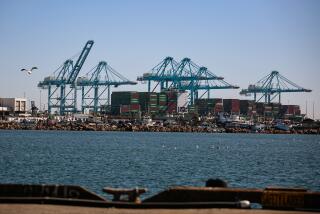Crane Operator Blamed by Nassco in the Deaths of 6
- Share via
An investigation has concluded that operator error was to blame for the July 10 accident that left six workers dead and six injured when a crane-lifted personnel basket plunged 30 feet to the deck of a Navy ship, National Steel & Shipbuilding Co. officials said Friday.
“Nassco believes it was operator error. Yes, it’s human error,” said Fred Hallett, Nassco vice president and spokesman.
Despite blaming the accident on crane operator Hugh Humphrey, Hallett declined to discuss the specific cause of the accident. He said that Nassco will leave that up to the federal Occupational Safety and Health Administration, which is heading an investigation of the accident.
OSHA officials warned that it was too early for Nassco to reach a conclusion.
“At this point it’s too premature. As far as I’m concerned, the investigation is still open and ongoing,” said Jerry Ryan, director of the local OSHA office. “I can’t confirm or deny it (operator error). I just don’t know.”
Humphrey, who has been a crane operator at Nassco for 13 years, could not be reached for comment Friday, but he has repeatedly refused to discuss the accident. Don Kidd, district representative for the Operating Engineers International Union--which is Humphrey’s union--also could not be reached for comment.
However, in a previous interview, Kidd said that Humphrey had been found qualified to operate the electric crane, commonly called a gantry, by the union and Nassco. Humphrey is on a paid leave of absence, and Hallett declined to discuss his status with Nassco until reports on the investigation are released later this month.
Hallett said that company officials concluded that Humphrey was to blame for the tragedy after investigators completed a series of tests on the crane involved in the accident. The three days of tests, which included a simulation of the accident, concluded Friday.
Hallett said the tests “detected no mechanical problems.” The tests included a thorough inspection of both crane cables, subjecting them to overload tests at 110% of their rated capacity. The basket involved in the accident was being transported on the crane’s “whip line,” which is rated at 10 tons and is used to carry lighter loads, Hallett said.
According to Hallett, a simulation test complete with a two-ton load--the approximate combined weight of the basket and 12 workers--was carried out Friday morning. Since the tests revealed no mechanical problems, there is no need to strip the crane for further tests, Hallett said.
“The company is convinced that the tests were extensive and would have picked up mechanical problems if one existed. They did not. Therefore, it was probably operator error,” Hallett said.
Overtime Policy to Be Reviewed
Hallett acknowledged that questions remain about the company’s overtime policy and the role that extended work hours might have played in the accident. Humphrey had worked 14 hours and then taken a 4 1/2-hour break on July 9, returning to work later that evening. The July 10 accident occurred minutes after midnight, about four hours after Humphrey had returned to work, Hallett said.
“He had dinner and rested, but didn’t sleep before returning to work,” said Hallett. “Mr. Humphrey was working under the overtime policy agreed to between the company and the unions. Both management and company will now be looking at that overtime policy for possible modification.”
Hallett suggested that OSHA will review the shipyard’s overtime policy and will probably make some recommendations. In addition, OSHA will look into the possibility of recommending that identical control panels be installed on all cranes operated in the United States, he said.
Reports detailing the investigation’s findings will be released in two to three weeks, Hallett said. He added that, during the investigation, OSHA did not mention the possibility of any company violations that might have contributed to the accident
According to Hallett, OSHA and the unions involved in the investigation have said that they will review the findings before commenting on the accident. “But Nassco believes that the results were apparent today. Therefore, we have drawn our own conclusion,” he said.
The crane has been under 24-hour guard since the accident. Hallett said that he expects OSHA to release the crane next week and that it should be back on the pier.
There has been some confusion over who manufactured the basket involved in the accident. Hallett said that he did not know the basket’s origin. “But since we are a steel company, I assume that we might have manufactured it. But I really don’t know,” Hallett said.
The July 10 accident, the worst ever at Nassco, occurred when the 6-by-4-foot, steel-mesh personnel basket, packed with 12 men and tools, fell 30 feet to a deck on the combat support ship Sacramento, a vessel under overhaul.
More to Read
Inside the business of entertainment
The Wide Shot brings you news, analysis and insights on everything from streaming wars to production — and what it all means for the future.
You may occasionally receive promotional content from the Los Angeles Times.










